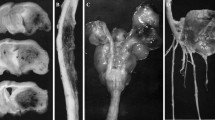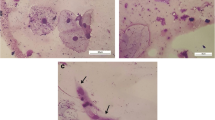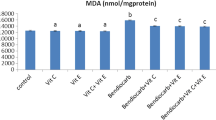Abstract
Pesticides and nitrites which could be available in foods are generally investigated individually, although they could be found in foods together and exhibit combined health effects. In this study we aimed to determine the combined effects of endosulfan which is a commonly used pesticide and N-nitroso-N-methylurea (NMU) which is a prototype for mammary tumor development in Sprague Dawley rats and could be formed in brine foods or also in body from nitrites which is commonly used in meat. Ninety female Sprague Dawley rats had been used. Animals were divided three groups which consisted 30 animals. The first group took a single dose endosulfan intraperitoneal (ip) on 19th day and a single dose NMU ip on 21 day, the second group took endosulfan by their drinking waters for the first 60 days of their life and a single dose NMU ip on 21 day, and the third group took only a single dose NMU ip on 21 day. Animals were controlled for their general health status, mammary mass develeopment, daily water consumption and weekly weight gain. At the end of the study rats were examinated carefully under anesthesia, and tissue samples were prepared from their mammary glands and intraabdominal organs. Tissue samples taken from mammary glands, liver and kidneys were histopathalogically examined. It was determined a statistically significant hepatomegally in the second group when we compared to other groups (p < 0.05). No animals developed mammary tumors. On the macroscopic examination and manual palpation of intraabdominal region, it was showed that solid tumors in kidneys as a ratio of 76.7% of the animals in the second group (bilateral in 1,3% of them, the others are unilaterally and 70% of the unilateral tumors are in the left kidneys while the rest of them are right localized). Also it was found that in the first group, 13.4% of the animals developed unilateral kidney tumors. The third group which had been applied only NMU developed no kidney or liver pathalogy macroscopically. As a result it was considered that a diversity which is named as “genetic shift” could be developed in our animal research center and because of this shift we could not developed NMU induced mammary tumors in our Sprague Dawley rats. But it has been showed that long term endosulfan expose has resulted in kidney tumor development for the first time. Because of the genetic shifting mentioned above, it should be tested whether this experimental animal cancer model is limited for our research center or not by obtaining sprague dawley animals from different centers. Interactions of living style, environmental factors and genetic properties in the development of cancer and its necessary to control all of three factors in order to reduce cancer frequency in public showed that the importance of interdiciplinary collaboration and public education. Consumers and appliers should be educated about using pestices, and healthy and safety food production and concumption should be considered as one of the primary subjects in public health studies.
Access this chapter
Tax calculation will be finalised at checkout
Purchases are for personal use only
Similar content being viewed by others
References
Abelsohn A, Gibson BL, Sanborn MD, Weir E (2002) Identifying and managing adverse environmental health effects: 5. Persistent organic pollutants. Can Med Assoc J 166(12):1549–1554
Adeoya-Osiguwa SA, Markoulaki S, Pocock V, Milligan SR, Fraser LR (2003) 17beta-estradiol and environmental estrogens significantly affect mammalian sperm function. Hum Reprod 18(1):100–107
Ahlbom J, Fredriksson A, Eriksson P (1995) Exposure to an organophosphate (DFP) during a defined period in neonatal life induces permanent changes in brain muscarinic receptors and behavior in adult mice. Brain Res 677:13–19
Carpy SA, Kobel W, Doe J (2000) Health risk of low-dose pesticides mixtures: A review of the 1985–1998 literature on combination toxicology and health risk assessment. J Toxicol Environ Health Part B, Crit Rev 3(1):1–25
Aguilera-Del AR, Valverde-Garcia A, Fernandez-Alba AR, Camacho-Ferre F (1997) Behaviour of endosulfan residues in peppers, cucumbers and cherry tomatoes grown in greenhouse: Evaluation of decline curves. Pest Sci 51:194–200
Amaraneni SR (2002) Persistence of pesticides in water, sediment and fish from fish farms in Kolleru Lake, India. J Sci Food Agric 82(8):918–923
Archibeque-Engle SL, Tessari JD, Winn DT, Kefe TJ, Nett TM, Zheng T (1997) Comparison of organochlorine pesticide and polychlorinated biphenyl residues in human breast adipose tissue and serum. J Toxicol Environ Health 52:285–293
Arrebola FJ, Egea-Gonzalez FJ, Moreno M, Fernandez-Gutierrez A, Hernandez-Torres ME, Martinez-Vidal JL (2001) Evaluation of endosulfan residues in vegetables grown in greenhouses. Pest Manage Sci 57(7):645–652
Cerrillo I, Granada A, Lopez-Espinosa MJ, Olmos B, Jimenez M, Cano A, Olea N, Olea-Serrano MF (2005) Endosulfan and its metabolites in fertile women, placenta, cord blood, and human milk. Environ Res 98(2):233–239
Safi JM, Abou-Foul NS, el-Nahhal YZ, el-Sebae AH (2002) Monitoring of pesticide residues on cucumber, tomatoes and strawberries in Gaza Governorates, Palestine. Nahrung 46(1):34–39
Barnard RJ (2004) Prevention of cancer through lifestyle changes. Evidence Based Complement Altern Med 1(3):233–239
Aklın E (2005) Et Ürünlerinde Nitrat, Nitrit ve Nitrozaminler. İzmir Veteriner Hekimler Odası. http://izmir-vho.org/izmir-vho/kutuphane.asp?talep=konu&id=129&g=3 (Erişimtarihi: 20.04.2005)
Calle EE, Frumkin H, Henley SJ, Savitz DA, Thun MJ (2002) Organochlorines and breast cancer risk. CA Cancer J Clin 52(5):301–309
Johnson FM (2002) How many food additives are rodent carcinogens? Environ Mol Mutagen 39(1):69–80
Macejova D, Brtko J (2001) Chemically induced carcinogenesis: a comparison of 1-methyl-1-nitrosourea, 7,12-dimethylbenzanthracene,diethylnitroso-amine and azoxymethan models (minireview). Endocr Regul 35(1):53–59
McCormick DL, Adamowski CB, Fiks A, Moon RC (1981) Lifetime dose-response relationships for mammary tumor induction by a single administration of N-methyl-N-nitrosourea. Cancer Res 41(5):1690–1694
Festing MFW, Altman DG (2002) Guidelines for the design and statistical analysis of experiments using laboratory animals. ILAR J 43(4):244–258
Masso-Welch PA, Darcy KM, Stangle-Castor NC, Ip MM (2000) A developmental atlas of rat mammary gland histology. J Mammary Gland Biol Neoplasia 5(2):165–185
Russo J, Russo IH (2000) Atlas and histologic classification of tumors of the rat mammary gland. J Mammary Gland Biol Neoplasia 5(2):187–200
Chou YC, Guzman RC, Swanson SM, Yang J, Lui HM, Wu V, Nandi S (1999) Induction of mammary carcinomas by N-methyl-N-nitrosourea in ovariectomized rats treated with epidermal growth factor. Carcinogenesis 20(4):677–684
Hu L, Lin L, Crist KA, Kelloff GJ, Steele VE, Lubet RA, You M, Wang Y (1997) Detection of differentially expressed genes in methylnitrosourea-induced rat mammary adenocarcinomas. J Cell Biochem Suppl 28–29:117–124
Bailey DW (1977) Genetic drift: the problem and its possible solution by frozen-embryo storage. Ciba Found Symp 291–303
Bailey DW (1982) How pure are inbred strains of mice? Immunol Today 3:210–214
Ames BN, Gold LS (1998) The causes and prevention of cancer: the role of environment. Biotherapy 11(2–3):205–220
Author information
Authors and Affiliations
Corresponding author
Editor information
Editors and Affiliations
Rights and permissions
Copyright information
© 2010 Springer-Verlag Berlin Heidelberg
About this chapter
Cite this chapter
Ogur, R., Tekbas, O.F. (2010). A Commonly Used Pesticide Endosulfan in Diet Could Cause Hepatomegaly and Kidney Tumor When Combined with Nitrosamines. In: Gökçekus, H., Türker, U., LaMoreaux, J. (eds) Survival and Sustainability. Environmental Earth Sciences. Springer, Berlin, Heidelberg. https://doi.org/10.1007/978-3-540-95991-5_54
Download citation
DOI: https://doi.org/10.1007/978-3-540-95991-5_54
Published:
Publisher Name: Springer, Berlin, Heidelberg
Print ISBN: 978-3-540-95990-8
Online ISBN: 978-3-540-95991-5
eBook Packages: Earth and Environmental ScienceEarth and Environmental Science (R0)




